YAMAHA MT-25 2016 Owner's Manual
Manufacturer: YAMAHA, Model Year: 2016, Model line: MT-25, Model: YAMAHA MT-25 2016Pages: 96, PDF Size: 5.16 MB
Page 21 of 96
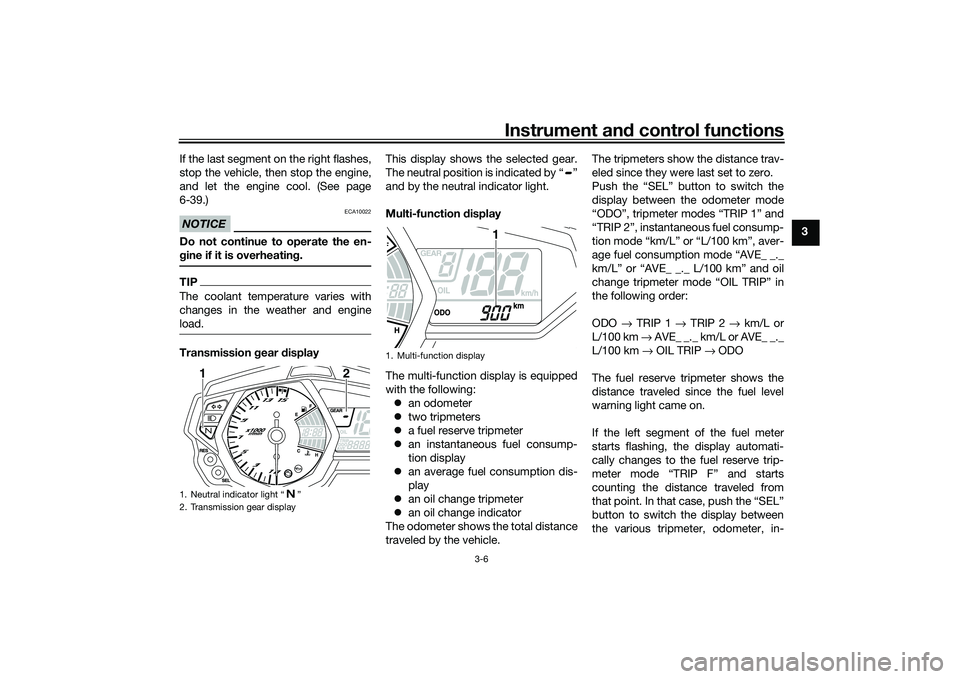
Instrument and control functions
3-6
3 If the last segment on the right flashes,
stop the vehicle, then stop the engine,
and let the engine cool. (See page
6-39.)
NOTICE
ECA10022
Do not continue to operate the en-
gine if it is overheating.TIPThe coolant temperature varies with
changes in the weather and engine
load.Transmission gear displayThis display shows the selected gear.
The neutral position is indicated by “ ”
and by the neutral indicator light.
Multi-function display
The multi-function display is equipped
with the following:
an odometer
two tripmeters
a fuel reserve tripmeter
an instantaneous fuel consump-
tion display
an average fuel consumption dis-
play
an oil change tripmeter
an oil change indicator
The odometer shows the total distance
traveled by the vehicle.The tripmeters show the distance trav-
eled since they were last set to zero.
Push the “SEL” button to switch the
display between the odometer mode
“ODO”, tripmeter modes “TRIP 1” and
“TRIP 2”, instantaneous fuel consump-
tion mode “km/L” or “L/100 km”, aver-
age fuel consumption mode “AVE_ _._
km/L” or “AVE_ _._ L/100 km” and oil
change tripmeter mode “OIL TRIP” in
the following order:
ODO → TRIP 1 → TRIP 2 → km/L or
L/100 km → AVE_ _._ km/L or AVE_ _._
L/100 km → OIL TRIP → ODO
The fuel reserve tripmeter shows the
distance traveled since the fuel level
warning light came on.
If the left segment of the fuel meter
starts flashing, the display automati-
cally changes to the fuel reserve trip-
meter mode “TRIP F” and starts
counting the distance traveled from
that point. In that case, push the “SEL”
button to switch the display between
the various tripmeter, odometer, in-1. Neutral indicator light “ ”
2. Transmission gear display
1
2
1. Multi-function display
1
UB04E0E0.book Page 6 Wednesday, September 2, 2015 3:51 PM
Page 22 of 96
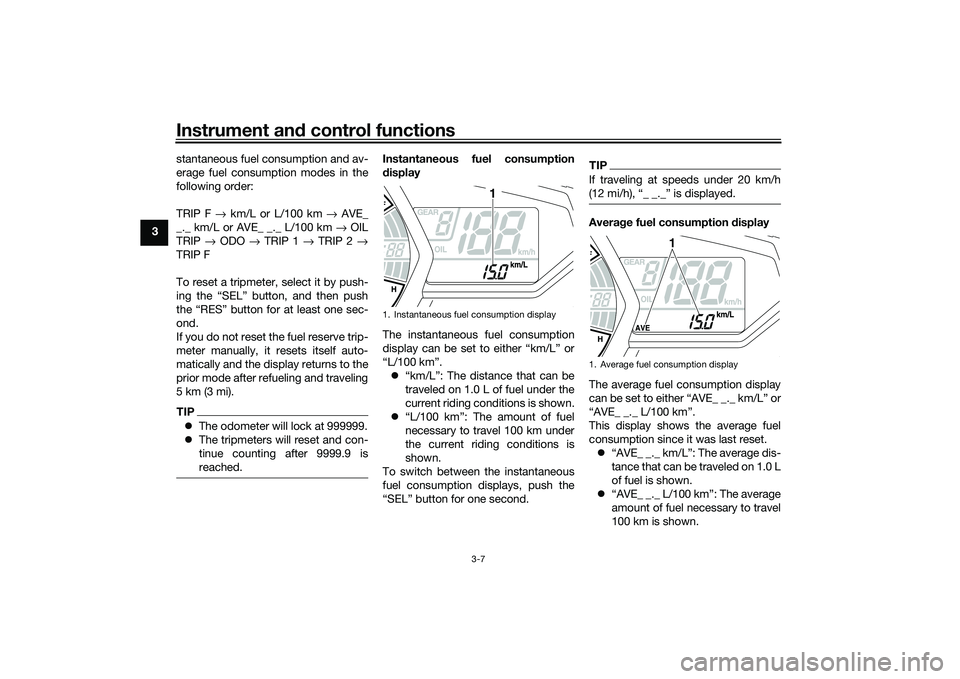
Instrument and control functions
3-7
3stantaneous fuel consumption and av-
erage fuel consumption modes in the
following order:
TRIP F → km/L or L/100 km → AVE_
_._ km/L or AVE_ _._ L/100 km → OIL
TRIP → ODO → TRIP 1 → TRIP 2 →
TRIP F
To reset a tripmeter, select it by push-
ing the “SEL” button, and then push
the “RES” button for at least one sec-
ond.
If you do not reset the fuel reserve trip-
meter manually, it resets itself auto-
matically and the display returns to the
prior mode after refueling and traveling
5 km (3 mi).
TIPThe odometer will lock at 999999.
The tripmeters will reset and con-
tinue counting after 9999.9 is
reached.
Instantaneous fuel consumption
display
The instantaneous fuel consumption
display can be set to either “km/L” or
“L/100 km”.
“km/L”: The distance that can be
traveled on 1.0 L of fuel under the
current riding conditions is shown.
“L/100 km”: The amount of fuel
necessary to travel 100 km under
the current riding conditions is
shown.
To switch between the instantaneous
fuel consumption displays, push the
“SEL” button for one second.
TIPIf traveling at speeds under 20 km/h
Average fuel consumption display
The average fuel consumption display
can be set to either “AVE_ _._ km/L” or
“AVE_ _._ L/100 km”.
This display shows the average fuel
consumption since it was last reset.
“AVE_ _._ km/L”: The average dis-
tance that can be traveled on 1.0 L
of fuel is shown.
“AVE_ _._ L/100 km”: The average
amount of fuel necessary to travel
100 km is shown.
1. Instantaneous fuel consumption display
1
1. Average fuel consumption display
1
UB04E0E0.book Page 7 Wednesday, September 2, 2015 3:51 PM
Page 23 of 96
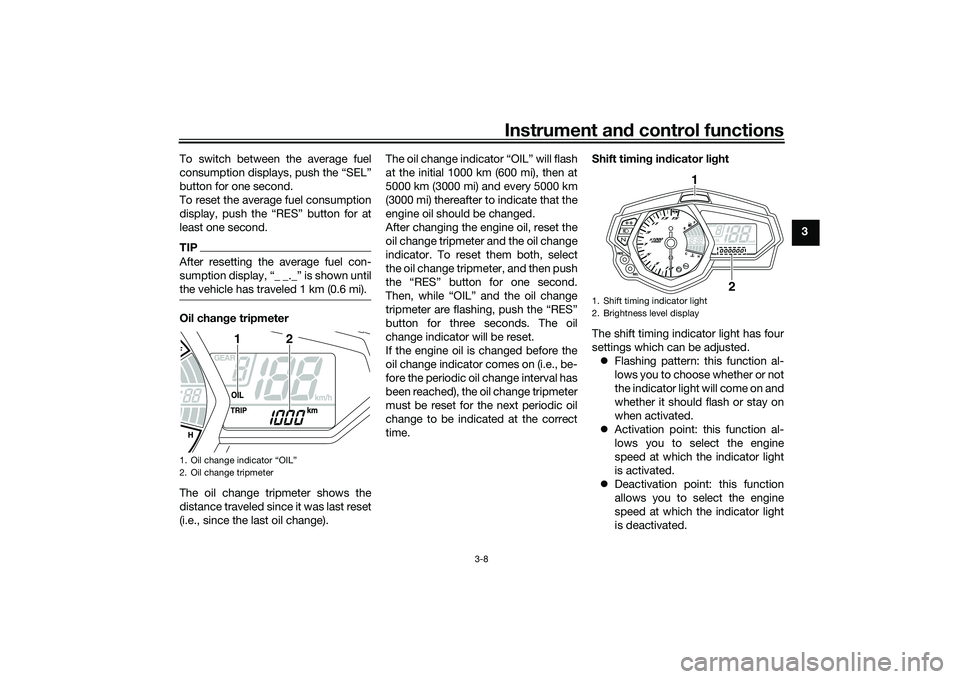
Instrument and control functions
3-8
3 To switch between the average fuel
consumption displays, push the “SEL”
button for one second.
To reset the average fuel consumption
display, push the “RES” button for at
least one second.
TIPAfter resetting the average fuel con-
the vehicle has traveled 1 km (0.6 mi).Oil change tripmeter
The oil change tripmeter shows the
distance traveled since it was last reset
(i.e., since the last oil change).The oil change indicator “OIL” will flash
at the initial 1000 km (600 mi), then at
5000 km (3000 mi) and every 5000 km
(3000 mi) thereafter to indicate that the
engine oil should be changed.
After changing the engine oil, reset the
oil change tripmeter and the oil change
indicator. To reset them both, select
the oil change tripmeter, and then push
the “RES” button for one second.
Then, while “OIL” and the oil change
tripmeter are flashing, push the “RES”
button for three seconds. The oil
change indicator will be reset.
If the engine oil is changed before the
oil change indicator comes on (i.e., be-
fore the periodic oil change interval has
been reached), the oil change tripmeter
must be reset for the next periodic oil
change to be indicated at the correct
time.Shift timing indicator light
The shift timing indicator light has four
settings which can be adjusted.
Flashing pattern: this function al-
lows you to choose whether or not
the indicator light will come on and
whether it should flash or stay on
when activated.
Activation point: this function al-
lows you to select the engine
speed at which the indicator light
is activated.
Deactivation point: this function
allows you to select the engine
speed at which the indicator light
is deactivated.1. Oil change indicator “OIL”
2. Oil change tripmeter
2
1
1. Shift timing indicator light
2. Brightness level display
1
2
UB04E0E0.book Page 8 Wednesday, September 2, 2015 3:51 PM
Page 24 of 96

Instrument and control functions
3-9
3Brightness: this function allows
you to adjust the brightness of the
indicator light.
To adjust the shift timing indicator light
1. Turn the key to “ ”.
2. Push and hold the “SEL” button.
3. Turn the key to “ ”, and then re-
lease the “SEL” button after five
seconds. The shift timing indicator
light can now be adjusted.
To set the flashing pattern1. Push the “RES” button to select
one of the following flashing pat-
tern settings:
On: the indicator light stays
on when activated. (This set-
ting is selected when the indi-
cator light stays on.)
Flash: the indicator light
flashes when activated. (This
setting is selected when the
indicator light flashes four
times per second.)
Off: the indicator light is deac-
tivated; in other words, it
does not come on or flash.(This setting is selected when
the indicator light flashes
once every two seconds.)
2. Push the “SEL” button to confirm
the selected flashing pattern. The
shift timing indicator light changes
to the activation point setting
mode.
The tachometer will show the current
setting r/min for the activation point
and deactivation point setting modes.
To set the shift activation point
TIPThe shift timing indicator light activa-
tion point can be set between 7000
r/min and 15000 r/min. From 7000
r/min to 12000 r/min, the indicator light
can be set in increments of 500 r/min.
From 12000 r/min to 15000 r/min, the
indicator light can be set in increments
of 200 r/min.1.
the desired engine speed for acti-
vating the indicator light.2.
the selected engine speed. The
control mode changes to the de-
activation point setting mode.
To set the deactivation point
TIPThe shift timing indicator light de-
activation point can be set be-
tween 7000 r/min and 15000
r/min. From 7000 r/min to 12000
r/min, the indicator light can be set
in increments of 500 r/min. From
12000 r/min to 15000 r/min, the in-
dicator light can be set in incre-
ments of 200 r/min.
Be sure to set the deactivation
point to a higher engine speed
than for the activation point, other-
wise the shift timing indicator light
will not come on.1. Push the “RES” button to select
the desired engine speed for de-
activating the indicator light.
2. Push the “SEL” button to confirm
the selected engine speed. The
control mode changes to the
brightness setting mode.
UB04E0E0.book Page 9 Wednesday, September 2, 2015 3:51 PM
Page 25 of 96

Instrument and control functions
3-10
3 To adjust the brightness
1. Push the “RES” button to select
the desired shift indicator light
brightness level.
2. Push the “SEL” button to confirm
the selected brightness level. The
display exits the shift timing light
control mode and returns to the
standard multi-function display
mode.
Self-diagnosis device
This model is equipped with a self-di-
agnosis device for various electrical
circuits.If a problem is detected in any of those
circuits, the engine trouble warning
light will come on and the display will
indicate an error code.
NOTICE
ECA11591
If the display indicates an error
code, the vehicle should be checked
as soon as possible in order to avoid
engine damage.
EAU1234H
Handlebar switchesLeft
Right
1. Engine trouble warning light “ ”
2. Error code display
2
1
1.
2. Dimmer switch / Ž
3. Turn signal switch / Ž
4. Horn switch Ž
1. Engine stop switch / Ž
2. Start switch Ž
4312
21
UB04E0E0.book Page 10 Wednesday, September 2, 2015 3:51 PM
Page 26 of 96

Instrument and control functions
3-11
3
EAU12361
Pass switch “PASS”
Press this switch to flash the headlight.
EAU62540
Dimmer switch “ / ”
Set this switch to “ ” for the high
beam and to “ ” for the low beam.TIPWhen the switch is set to low beam,
only the right headlight bulb comes on.
When the switch is set to high beam,
both headlight bulbs come on.
EAU12461
Turn signal switch “ / ”
To signal a right-hand turn, push this
switch to “ ”. To signal a left-hand
turn, push this switch to “ ”. When
released, the switch returns to the cen-
ter position. To cancel the turn signal
lights, push the switch in after it has re-
turned to the center position.
EAU12501
Horn switch “ ”
Press this switch to sound the horn.
EAU12661
Engine stop switch “ / ”
Set this switch to “ ” before starting
the engine. Set this switch to “ ” to
stop the engine in case of an emergen-
cy, such as when the vehicle overturns
or when the throttle cable is stuck.
EAU12713
Start switch “ ”
Push this switch to crank the engine
with the starter. See page 5-1 for start-
ing instructions prior to starting the en-
gine.
EAU62500
The engine trouble warning light will
come on when the key is turned to “ ”
and the start switch is pushed, but this
does not indicate a malfunction.
EAU12822
Clutch leverThe clutch lever is located on the left
side of the handlebar. To disengage
the clutch, pull the lever toward the
handlebar grip. To engage the clutch,
release the lever. The lever should be
pulled rapidly and released slowly for
smooth clutch operation.
The clutch lever is equipped with a
clutch switch, which is part of the igni-
tion circuit cut-off system. (See page
3-20.)1. Clutch lever1
UB04E0E0.book Page 11 Wednesday, September 2, 2015 3:51 PM
Page 27 of 96
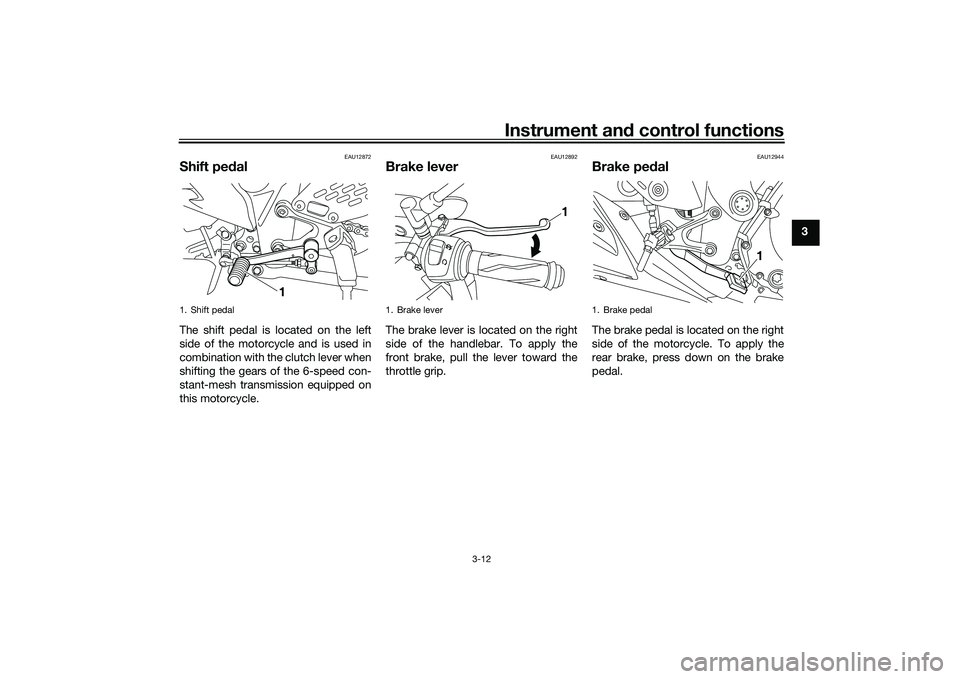
Instrument and control functions
3-12
3
EAU12872
Shift pedalThe shift pedal is located on the left
side of the motorcycle and is used in
combination with the clutch lever when
shifting the gears of the 6-speed con-
stant-mesh transmission equipped on
this motorcycle.
EAU12892
Brake leverThe brake lever is located on the right
side of the handlebar. To apply the
front brake, pull the lever toward the
throttle grip.
EAU12944
Brake pedalThe brake pedal is located on the right
side of the motorcycle. To apply the
rear brake, press down on the brake
pedal.
1. Shift pedal
1
1. Brake lever
1
1. Brake pedal
1
UB04E0E0.book Page 12 Wednesday, September 2, 2015 3:51 PM
Page 28 of 96
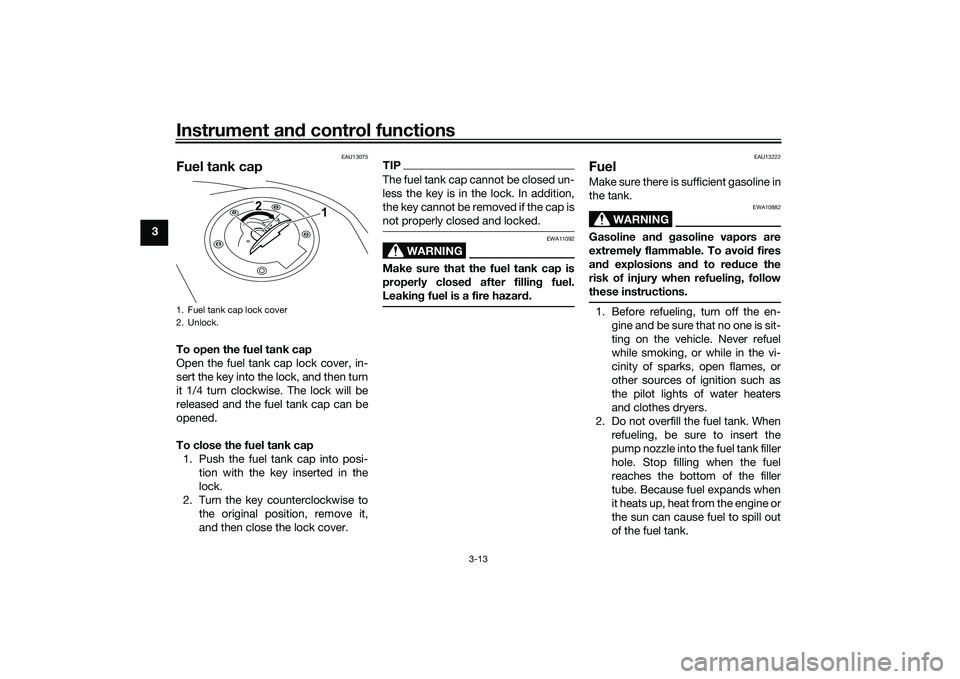
Instrument and control functions
3-13
3
EAU13075
Fuel tank capTo open the fuel tank cap
Open the fuel tank cap lock cover, in-
sert the key into the lock, and then turn
it 1/4 turn clockwise. The lock will be
released and the fuel tank cap can be
opened.
To close the fuel tank cap
1. Push the fuel tank cap into posi-
tion with the key inserted in the
lock.
2. Turn the key counterclockwise to
the original position, remove it,
and then close the lock cover.
TIPThe fuel tank cap cannot be closed un-
less the key is in the lock. In addition,
the key cannot be removed if the cap is
not properly closed and locked.
WARNING
EWA11092
Make sure that the fuel tank cap is
properly closed after filling fuel.
Leaking fuel is a fire hazard.
EAU13222
FuelMake sure there is sufficient gasoline in
the tank.
WARNING
EWA10882
Gasoline and gasoline vapors are
extremely flammable. To avoid fires
and explosions and to reduce the
risk of injury when refueling, follow
these instructions.1. Before refueling, turn off the en-
gine and be sure that no one is sit-
ting on the vehicle. Never refuel
while smoking, or while in the vi-
cinity of sparks, open flames, or
other sources of ignition such as
the pilot lights of water heaters
and clothes dryers.
2. Do not overfill the fuel tank. When
refueling, be sure to insert the
pump nozzle into the fuel tank filler
hole. Stop filling when the fuel
reaches the bottom of the filler
tube. Because fuel expands when
it heats up, heat from the engine or
the sun can cause fuel to spill out
of the fuel tank.
1. Fuel tank cap lock cover
2. Unlock.
1 2
UB04E0E0.book Page 13 Wednesday, September 2, 2015 3:51 PM
Page 29 of 96
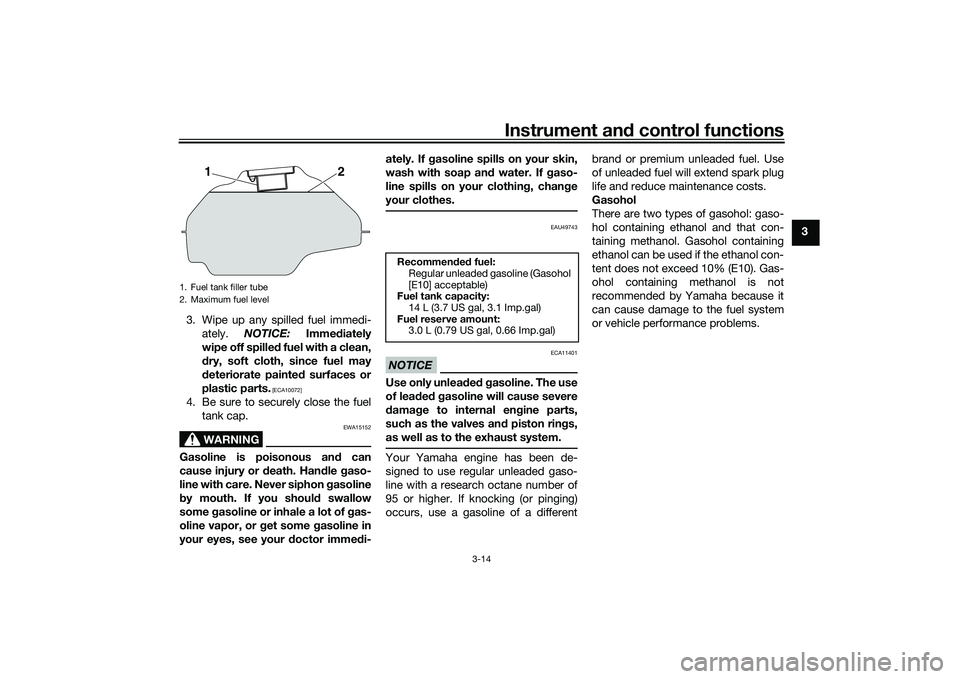
Instrument and control functions
3-14
3
3. Wipe up any spilled fuel immedi-
ately. NOTICE: Immediately
wipe off spilled fuel with a clean,
dry, soft cloth, since fuel may
deteriorate painted surfaces or
plastic parts.
[ECA10072]
4. Be sure to securely close the fuel
tank cap.
WARNING
EWA15152
Gasoline is poisonous and can
cause injury or death. Handle gaso-
line with care. Never siphon gasoline
by mouth. If you should swallow
some gasoline or inhale a lot of gas-
oline vapor, or get some gasoline in
your eyes, see your doctor immedi-ately. If gasoline spills on your skin,
wash with soap and water. If gaso-
line spills on your clothing, change
your clothes.
EAU49743
NOTICE
ECA11401
Use only unleaded gasoline. The use
of leaded gasoline will cause severe
damage to internal engine parts,
such as the valves and piston rings,
as well as to the exhaust system.Your Yamaha engine has been de-
signed to use regular unleaded gaso-
line with a research octane number of
95 or higher. If knocking (or pinging)
occurs, use a gasoline of a differentbrand or premium unleaded fuel. Use
of unleaded fuel will extend spark plug
life and reduce maintenance costs.
Gasohol
There are two types of gasohol: gaso-
hol containing ethanol and that con-
taining methanol. Gasohol containing
ethanol can be used if the ethanol con-
tent does not exceed 10% (E10). Gas-
ohol containing methanol is not
recommended by Yamaha because it
can cause damage to the fuel system
or vehicle performance problems.
1. Fuel tank filler tube
2. Maximum fuel level
2
1
Recommended fuel:
Regular unleaded gasoline (Gasohol
[E10] acceptable)
Fuel tank capacity:
14 L (3.7 US gal, 3.1 Imp.gal)
Fuel reserve amount:
3.0 L (0.79 US gal, 0.66 Imp.gal)
UB04E0E0.book Page 14 Wednesday, September 2, 2015 3:51 PM
Page 30 of 96
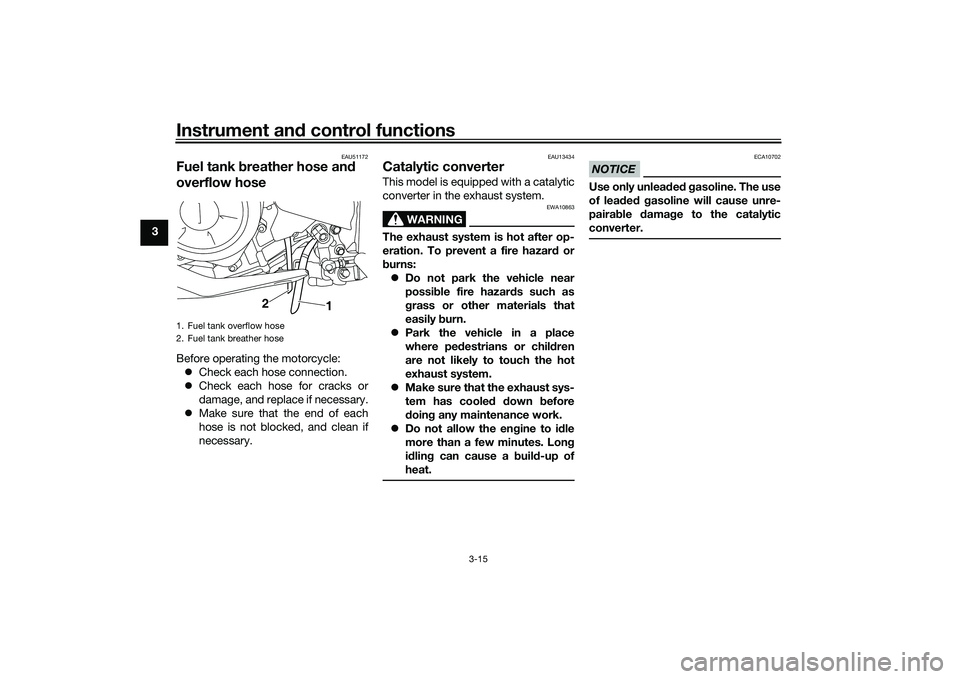
Instrument and control functions
3-15
3
EAU51172
Fuel tank breather hose and
overflow hoseBefore operating the motorcycle:
Check each hose connection.
Check each hose for cracks or
damage, and replace if necessary.
Make sure that the end of each
hose is not blocked, and clean if
necessary.
EAU13434
Catalytic converterThis model is equipped with a catalytic
converter in the exhaust system.
WARNING
EWA10863
The exhaust system is hot after op-
eration. To prevent a fire hazard or
burns:
Do not park the vehicle near
possible fire hazards such as
grass or other materials that
easily burn.
Park the vehicle in a place
where pedestrians or children
are not likely to touch the hot
exhaust system.
Make sure that the exhaust sys-
tem has cooled down before
doing any maintenance work.
Do not allow the engine to idle
more than a few minutes. Long
idling can cause a build-up of
heat.
NOTICE
ECA10702
Use only unleaded gasoline. The use
of leaded gasoline will cause unre-
pairable damage to the catalytic
converter.
1. Fuel tank overflow hose
2. Fuel tank breather hose
2
1
UB04E0E0.book Page 15 Wednesday, September 2, 2015 3:51 PM